Quick Summary:
This blog post covers the difference between POC vs MVP vs Prototype to validate the assumptions with the minimum set of features for its initial users. We’ll go through each approach in detail, compare them and discuss how to choose the right strategy closest to product-market fit for your app development.
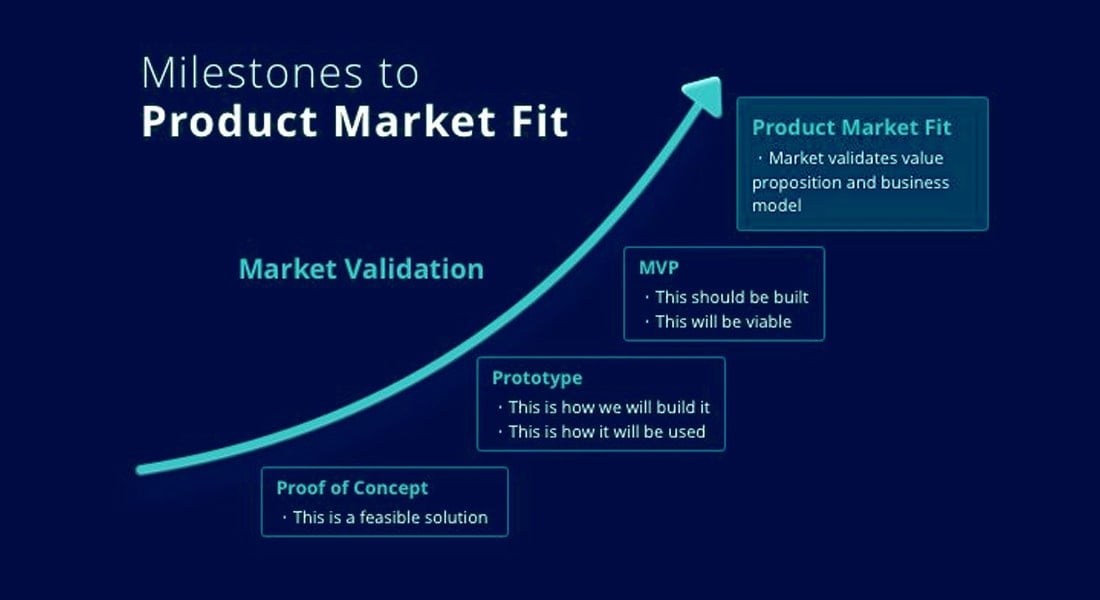
Table of Contents
Introduction
Every business faces many challenges while choosing an MVP, POC, and Prototype in the early stage of its product development. It may sometimes lead to a wrong selection strategy as well. By doing so, your organization may reveal the finances and cease the overall business growth. Depending on the project roadmap, MVP vs Prototype methods can be used together or independently.
Some of the Fortune 500 organizations too failed to woo their customers when they introduced a new app in the market at their initial stage. Have you wondered why? When it comes to developing a new product, you need to ensure that end-users actual problems are being placed with the right product-market fit solution.
Let us delve deep into the concepts of POC vs Prototype vs MVP, an ideal approach to kickoff startup.
An Overview of MVP, Prototype, and POC
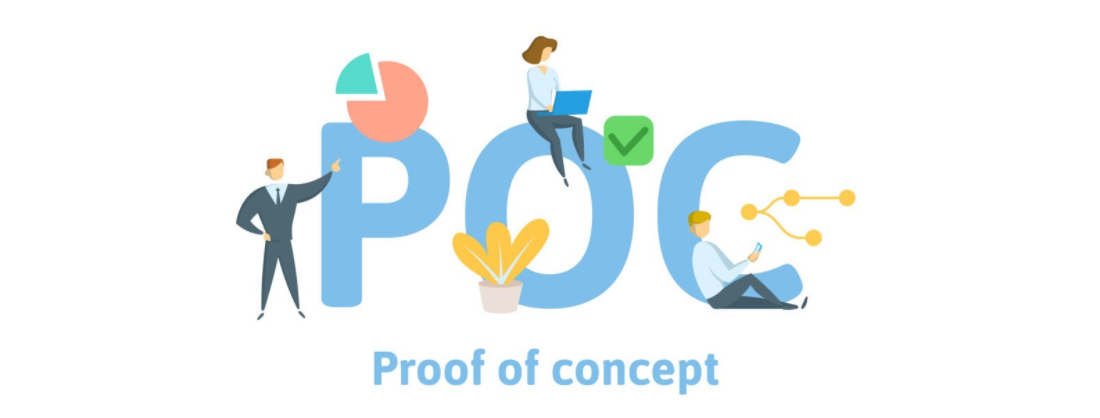
A Proof of Concept is a mini project used to verify technical concepts such as technology, method, and integration. POC is used before you launch the product in the market and before you initiate your product development.
The goal is to assess the idea’s feasibility and validate the assumptions taken into the picture. Proof of Concept is not publicly available to every customer, making it unusable because it verifies if the idea is operationally workable.
If your startup is innovating, the viability of the new concept’s practical implementation is uncertain. Depending on the initial study, poc app development allows you to assess if your product runs technically flawless or not. If it doesn’t work, it might be aborted or changed initially. It is not mandatory to develop a POC if the concept is already available in the market.
What Do You Get With the POC Approach? POC is a tool for validating a unique product. Have a sneak peek at the benefits of executing the POC approach:
- Attracts the initial investors: A POC works best to attract investments and investors who’re willing to fund proven ideas.
- Saves a good amount of time: In a short period, POC makes sure that you know if your project can be implemented and proceed to the next startup development level.
- Make the correct choice: To reduce major risks, you can create multiple POCs using different technologies.
- Staying ahead of the competition: A POC is an inexpensive way to develop a new and unique product that will revolutionize the business.
How Does a Proof of Concept Work?
If you’re doubtful about the feasibility of your idea, POC has two possibilities for you either a yes or a no. With a positive response, you can continue to build your project, whereas an adverse reaction won’t let you continue with a potentially non-viable project.
As a part of an internal approach, POC process flow is not meant to be shown to your users but to solve serious issues. Pitching it to your potential investors can reap the fruits of raising seed funding.
Success Story of Walmart POC
Blockchain technology is used to create cryptocurrencies. However, Walmart decided to execute this technology to improve its logistics system by tracing product origins. The Walmart team created a POC to understand whether blockchain technology is suitable for this idea.
In 2016, they created two mini products to test blockchain technology. The first one was used to track mangoes’ origin in the US, and the other was to track the meat sold by Walmart stores in China.
These two projects were created to speed up the process by determining the origin of successfully tested goods. Thanks to blockchain technology. They helped the company track product origins, see dispatch dates, check logistics, and arrive at supermarkets within a few seconds.
Today, Walmart is successfully implementing blockchain technology by expanding the functionality of its blockchain-based system.
Let’s transform your million-dollar idea into a successful product.
Leverage the skill and expertise of the top 1% experts for your MVP development.
Prototype
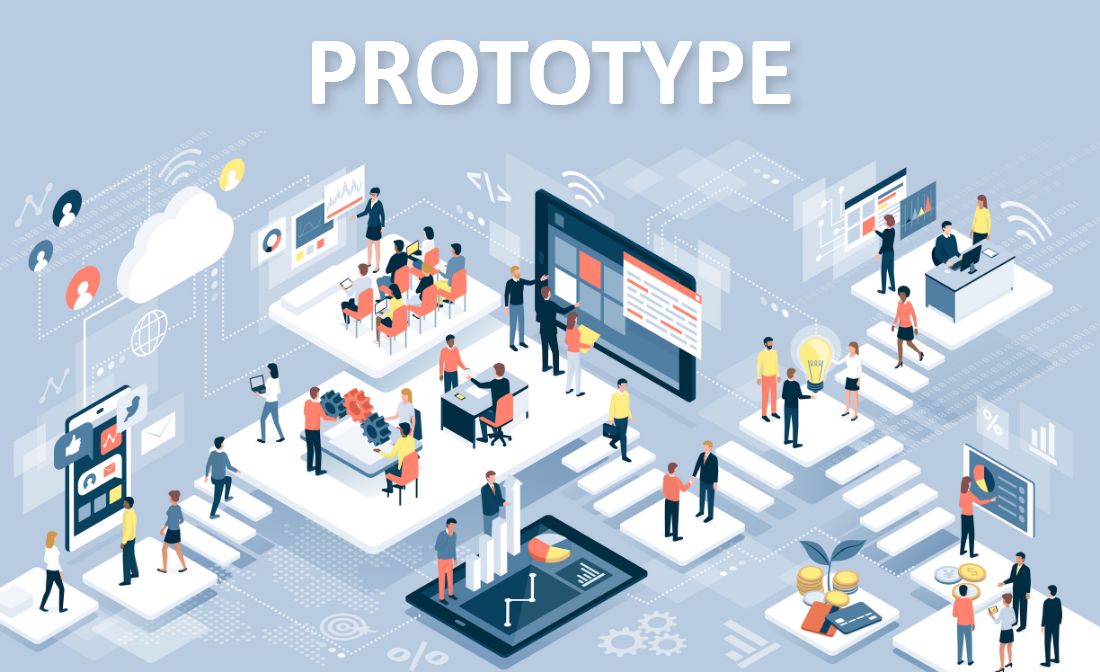
Goal: To demonstrate how the product will look
A prototype is an interactive mirror of your products’ eye that manifests the main design elements and determines the user flows. It focuses on determining the look and feel of the product and understanding the fundamental project workflows needed to be included during the product development stage.
What is a Mobile app prototype?
A mobile app prototype shows how an app will flow from one screen to another and processes the app development. You can visualize the UX before you start developing your project. Many individuals get confused about the Proof of concept vs. Prototype. The basic difference between proof of concept and prototype is that the former demonstrates whether a product or its features could be developed.
In contrast, the latter demonstrates how it will be developed.
What Do You Get With the Prototype Approach?
Have a look at the benefits of implementing a Prototype for your startup:
- Design concept validation: You can run multiple tests on a design until you get the desired output.
- Resource savings: It helps you to determine potential design flaws before product development, prevent rework, and reduce unnecessary expenses.
- Immediate feedback: While testing the prototype, you get direct feedback from live people that helps you quickly identify downsides, fix them, and continue further development.
- Initial investment: A tested prototype with great looks can be shown to your investors, and you can convince them that your idea is worth investing in.
How does Prototyping Work?
How to build a product prototype? To create a simplified introductory design, the startup owner will define all system requirements. Then, the prototype will be developed & tested. Once you identify the errors and strong points, the developer evaluates the feedback.
Each prototype leads to the development of a new system. The entire development system is repeated until its final version meets the requirements and user specifications. This approach is the most widespread. Thus, the process flow is modified following the chosen prototyping type.
Original iPhone Prototype From 1983
Do you know that the fan following for iPhone began with a prototype? We saw the first iPhone in 2007, but the company had already gone through several iterations before zeroing down to this product which took the market by storm. The image below represents the prototype for a touchscreen Apple phone.
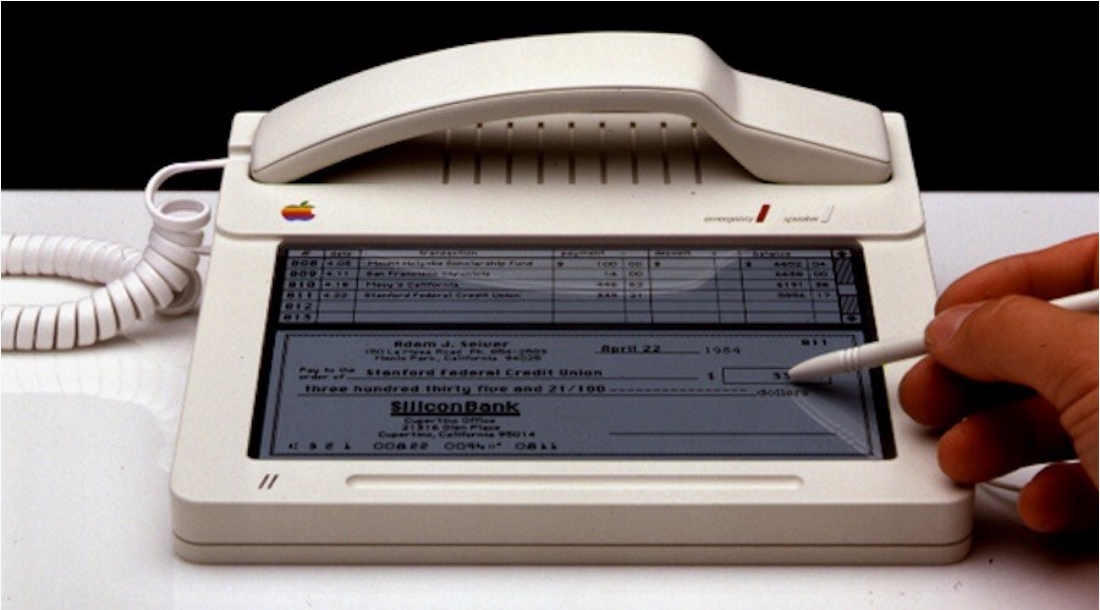
Around 1983, this prototype was designed featuring a touchscreen and stylus input and was quite slick for a device from the early 80s. It looks like the company wanted to design a touchscreen and hybrid phone as early as 1983. And after testing and improvising on this prototype, the first iPhone was launched in the market around 2007.
The discovery phase of your project is the most important period before starting with the development phase.
Get in touch with the most renowned MVP development company to bridge your path to a scalable, market-worthy product.
Minimum Viable Product (MVP)
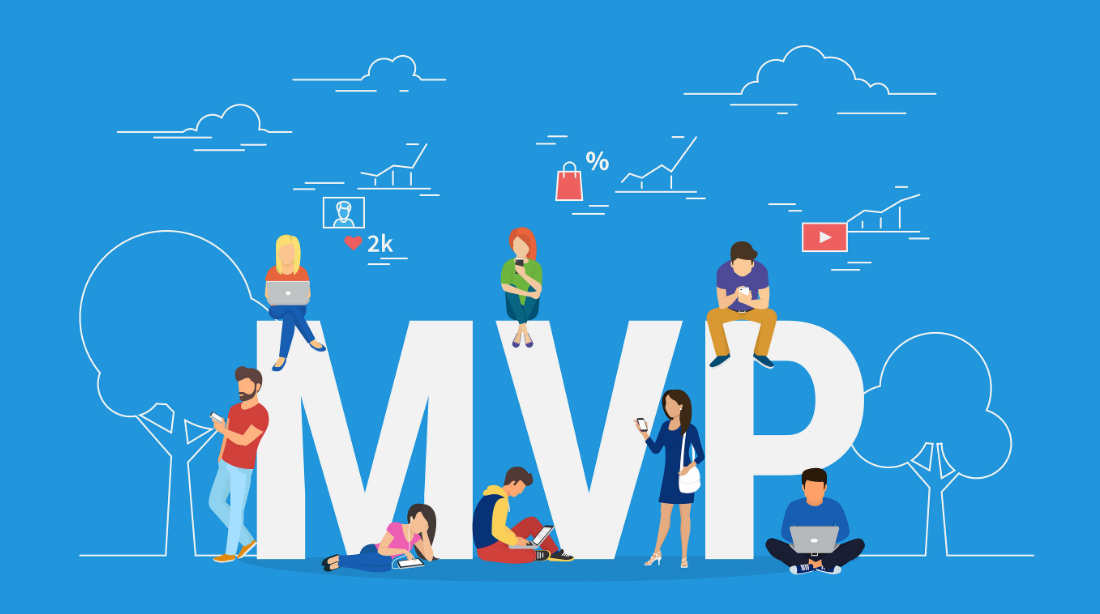
Goal: Launch and iterate based on user feedback
A Minimum Viable Product has a minimum required set of features to serve its customers and gain instant feedback for further improvement. An MVP is a functional app loaded with superior features that represent the application. It lets you know what your users like and what they anticipate in your final product.
From fundamental concept to the existence, MVP is a primary system on its own that depicts your system’s basic version providing a small set of users and comments. It is a combination of microservices that mainly focus on creating one whole thing at a time. MVP is one of the most in-demand approaches for mapping product fit.
What Do You Get With the MVP Approach?
Here are the main benefits of an MVP:
- Optimization of Expenses: MVP is a device that demands less time and money for development and enables you to plan the development path.
- A tool to attract your first user: MVP is not a thoroughly refined product, but you can originate it on the market and get your first profitable client.
- A chance to draw investors’ attention: Nobody wants to spend on ideas with unpredictable market demand. A wholly developed MVP gaining accurate user feedback is excellent assurance for investors to vest their interests.
MVP Example – Twitter
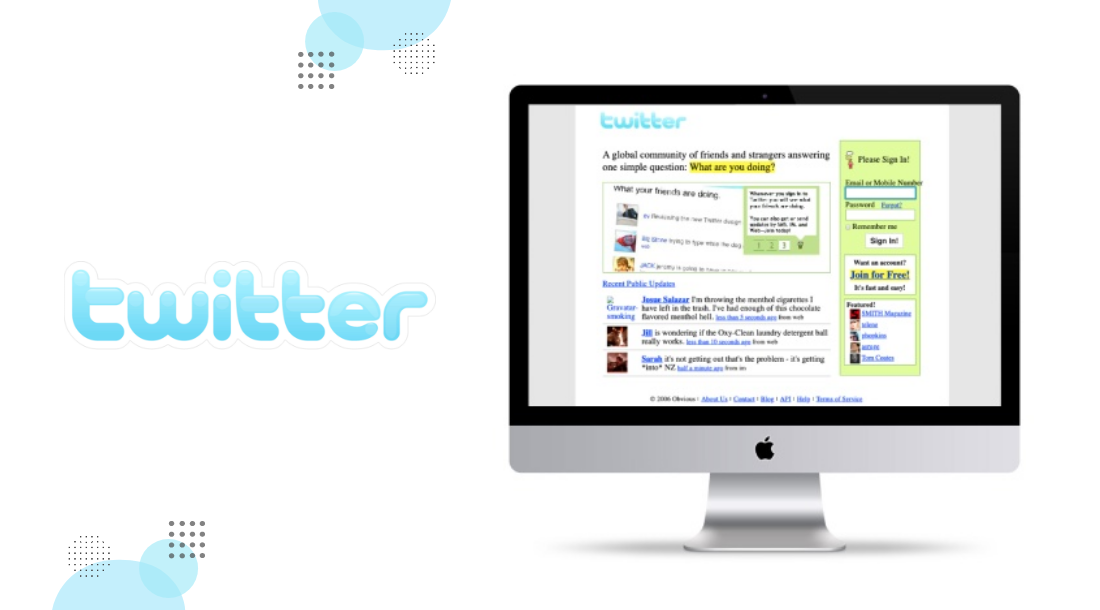
In 2001, Odeo’s podcasting business model was under threat because of the launch of Apple’s iTunes. So, they came up with an out-of-the-box idea of running hackathons to survive in the market. They conducted hackathons, which focused on generating new ideas; from the participants. It still amuses everyone to this day that Odeo’s hackathon led to the creation of the initial stage for the social media giant ‘Twitter.’
In the beginning, the employees of Odeo used this idea internally. It became trendy among employees in less time that they even started spending money posting on the platform. And ‘Twittr’ which was at its MVP stage, was scaled to one of the most loved social media platforms, “Twitter”!
POC vs Prototype vs MVP: What’s The Difference?
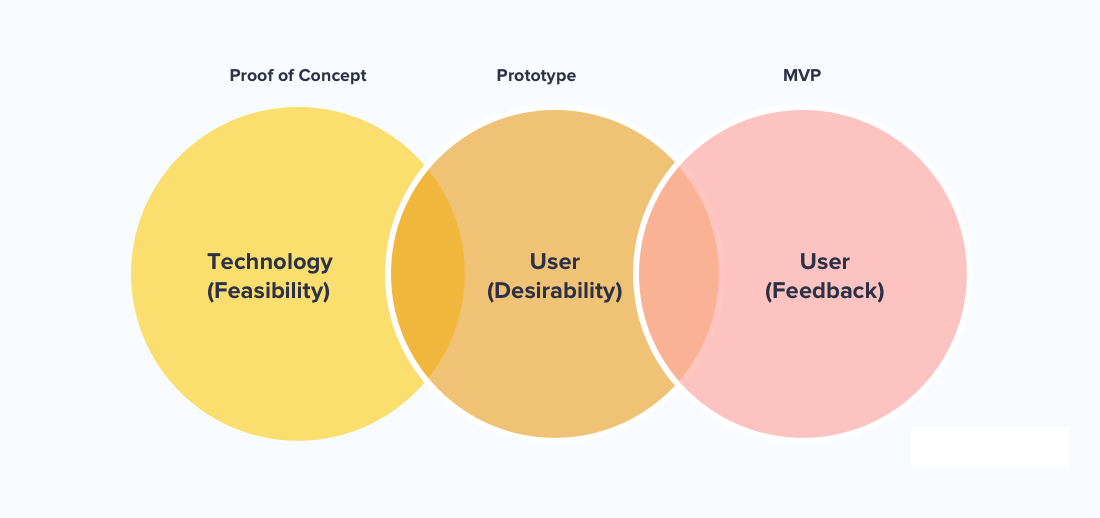
POC, MVP, and Prototype are different from each other, and so is the objective. You will easily understand the comparison of POC vs MVP vs prototype by reading in detail.
What Is the Difference between a POC and Prototype?
A proof of concept justifies the viability of bringing the idea into existence. It essentially addresses the question of feasibility that a certain idea can be realized with a specific technology.
Usually, a POC serves as an internal project, whereas a prototype can be shipped for initial feedback to learn more about the flow and design.
What Is the Difference between an MVP and Prototype?
An MVP is essentially a finished product, even if it lacks some features. With an MVP, you can collect user analytics and add or refine features in the next iterations.
A prototype lacks the business logic of your product and addresses the questions of design and UX.
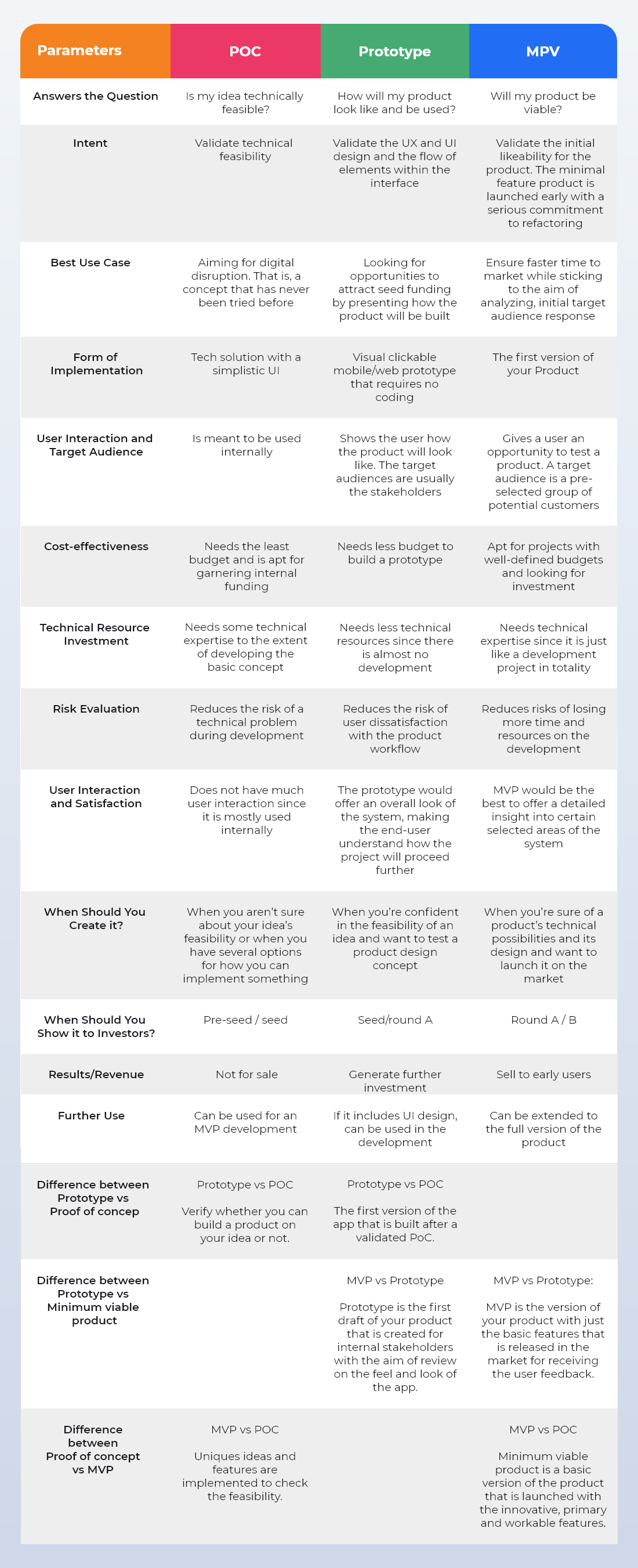
Key Considerations Before Developing an MVP, Prototype, or POC
Before choosing whether you need to develop a POC, MVP, or prototype, few inquiries need to be responded to and grasped. Once you classify the answers to these questions, you are all ready to pick from these three is undoubtedly the correct one.
- Is your idea unique?
- What do you want to verify?
- Is it required to find out if your target audience needs your product?
- Who is your target audience?
- What are your validation criteria?
- What does your business need?
- What are your measures for budget, time, and effort?
- What is your aspired output in terms of production willingness?
- Is your technology for the project discussed?
If answers to the above questions are YES, then you need to go the safe way and develop from proof of concept to prototype to MVP.
POC vs Prototype vs MVP: How to Choose the Best Approach?
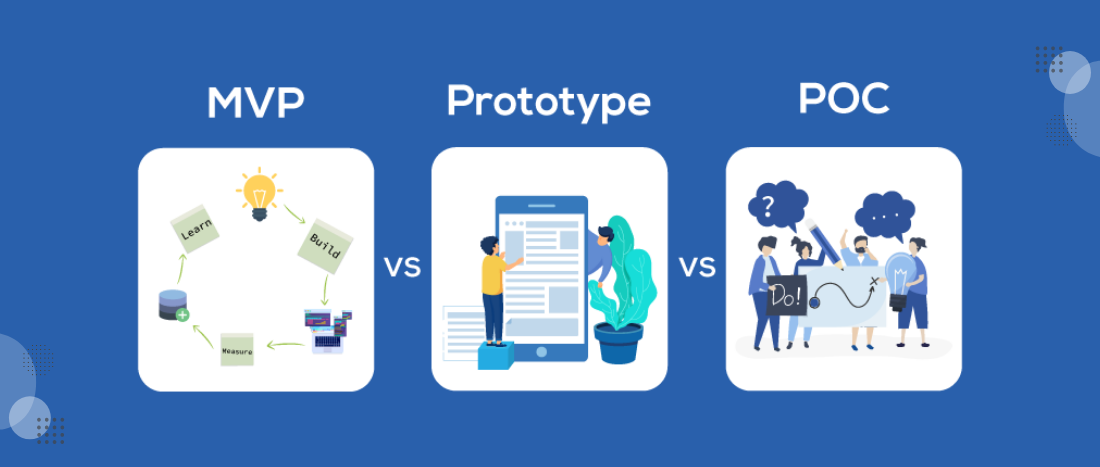
When to choose a POC?
POC is the first step while developing a fully-fledged product. You can implement this approach if the statements given below align with your current goals:
- When creating a new product with the idea that has not been tried and tested before.
- You want to confirm your idea’s feasibility before investing your time, efforts, and resources into product development.
- Make sure to verify your product’s industrial utility to secure your first investment.
- Do not implement the previously applied technology in your industry.
- When you aim to share your product and internal knowledge with the team members.
When to choose a prototype?
After creating a POC, you can move further to the prototype stage. Some clues that reveal your need to begin developing a prototype is:
- When you want to give life to your product’s look and feel to see how it will turn out at full scale.
- When you’ve limited time and money to showcase your product’s design and UX flow to attract investors.
- You aim to design a product having excellent user flow and user experience.
- When you have a quick deadline for presenting your idea to the investors.
When to choose a Minimum Viable Product (MVP)?
An MVP is not a mature product, but it is considered the last stage towards its development. You can implement this approach if:
- You want to invest minimum time and money in developing your product with the necessary features.
- You want immediate user feedback that can construct the base for further improvements.
- When you need higher retention at a lower cost.
From POC to Prototype to MVP: One But Not the Same
You can clearly interpret from this bubble chart below the representation of POC vs MVP vs Prototype. You can implement these approaches for various purposes at the stage of development. Thus, they are not interchangeable.
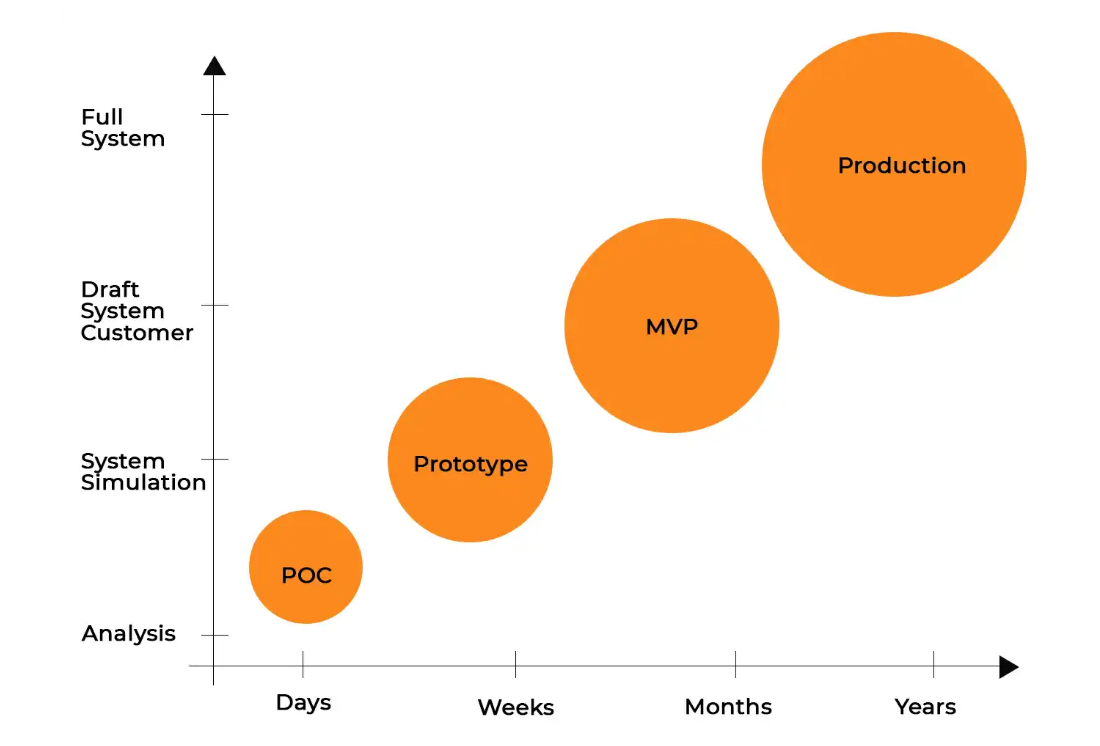
If you are trying to choose between POC vs MVP vs Prototype, consider developing a final product that implements each of these three phases.
Here are the benefits of implementing such approaches:
- Concept Testing: Before product development, you have the opportunity to test the idea and recognize your target audience.
- Faster Development: When you’re developing a product using this approach, you need a minimum set of features. Similarly, it would require more time to deliver a complete product. Thus, your product development will be faster when you upgrade your app development from POC to Prototype to MVP.
- User Loyalty: It allows users to interact with your product at the prototyping stage; you automatically generate enthusiasm and brand awareness.
- Quick Feedback: You may have some expectations on how your product will look and perform, but your ideas may not connect to what the users have. The earlier you get the user feedback, the quicker will be the improvement in the user demand.
- Low-Risk Investment: Investors are more likely to fund your idea if you ensure low investment risk.
Conclusion
Product development is like investigating with a vision in mind. The process starts with placing the foundation right to create a POC and a prototype, supported by an MVP. MVP is a great example of a functional product from all these approaches. But that doesn’t mean the other two methods don’t influence full-stack development.
In the explanation above, I tried to erase the thin line between poc vs mvp vs prototype to validate a successful startup product. Now, if you’re planning to develop a product using these approaches, hand your project to safe hands by searching for the best MVP development company. Make sure that it offers a dedicated MVP software development team and aims to nail down the viability and feasibility of your million-dollar product idea into a successful startup.
Frequently Asked Questions (FAQs)
An MVP is a minimum version of the final product, and it’s delivered to the market right away. This means that it has to be simple and well-polished, without bugs or other problems. On the other hand, prototypes are created for the sake of finding those errors and often are far from being perfect
Prioritization Matrix
This step helps you identify where you can make the most impact on the urgency of the feature. Using a prioritization matrix, you can decide what needs to be included in your MVP and what features can be included in later releases.
Prototypes will have been followed to shape how the final product will work. Once you’ve refined these prototype designs to a point you’re happy with, the next stage will be a pilot. This is a stepping stone to your full launch of a minimum viable product (MVP) or service.
A Prototype can be a test case for an idea. It is achieved not by building a small-scale version of a service or product but by testing several parts to unveil the various possibilities of scaling it to reach the final service or product.
Your Success Is Guaranteed !
We accelerate the release of digital product and guaranteed their success
We Use Slack, Jira & GitHub for Accurate Deployment and Effective Communication.




